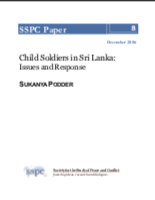Child Soldiers in Sri Lanka: Issues and Response

One of the alarming trends of recent warfare pertains to the widespread use of children as soldiers. In an oft-quoted estimate children today are said to be participating as active combatants in over seventy five percent of the world’s armed conflicts. Child soldiers are generally defined as “persons under the age of eighteen years engaged in organized and politically directed violence as part of an armed group.” The problem also increasingly defies gender boundaries. Girls serve not only as soldier-wives but also as part of fidayeen or suicide squads given that they look relatively harmless and less suspicious than men. While this co-option of youth for armed violence is not an entirely new phenomenon, a disturbing trend lies in the fact that, while earlier, child soldiers were recruited only when the supply of adult soldiers ran short, today society’s youngest are often recruited as a matter of preference.
The paper is organised into four parts. The first section provides a background analysis into the history and reasons for child recruitment by the LTTE. Here, it explains the strategies of recruitment, indoctrination and training by the Tamil Tigers. The next section focuses on the international legal obligations of the LTTE, and the efforts by national and international agencies to bring an end to child recruitment. The mainstreaming of the child soldier issue into the 2002-2006 peace process resulted in efforts to rehabilitate released child cadres under an Action Plan signed between the LTTE and the GoSL. These are explained in the third part. The status of implementation of the Action Plan together with current statistics on both recruitment and release compiled by the United Nations Children’s Emergency Fund (UNICEF) are reviewed in the final section. The paper would like to draw conclusions about how far the international response to dealing with the child soldier problem has fared in case of Sri Lanka’ s two decade old ethnic conflict through analysing all the previous parts of this paper. The study concludes that while impressive normative and institutional enforcement mechanisms have been developed and operationalised, the on going recruitment and slow pace of release by the LTTE calls for a review on the approaches so far pursued.